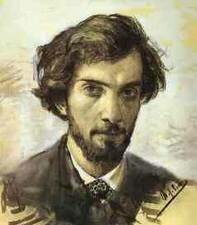 Isaac Iljich Levitan18.08.1860 Kibarty, Lithuania - 22.08.1900 Moscow Art history: PeredvizhnikiCanvases of Isaac Iljich Levitan [18 canvases]
Biography of Isaac Iljich LevitanThe work of Isaac Ilyich Levitan belongs to the highest achievements of Russian culture. Its significance is compared with the works of such classics as Anton Chekhov, Pyotr Tchaikovsky and Konstantin Stanislavsky. Levitan was born in 1860 into a poor but educated Jewish family. In the late 1860s, the family moved to Moscow, where Isaac studied at the Moscow School of Painting and Sculpture from 1873 till 1883. He lost his mother in 1875 and his father two years later. He was left penniless and homeless in Moscow, sleeping alternately in the homes of relatives and friends, sometimes spending the night in the empty classrooms of the school. A nightwatch took pity on the youth and let him sleep in his cubicle. The School waived his tuition fee “because of extreme poverty and in recognition of his singular success in art”. The greatest role in the forming of Levitan’s creative personality belongs to his favorite teacher Alexey Savrasov, the most lyrical among Russian landscape painters of the 1860s-1870s, who influenced many well-known artists of Levitan’s generation – Mikhail Nesterov, Constantin Korovin and others. Of course, Levitan’s passionate love for poetry and music, his persistent studying of pleine-air, the sunny paintings of Vasiliy Polenov, who also taught at the School, the works of the French painters of the Barbizon school, of Camille Corot were of great importance for the young artist. As any great talent did and does, Levitan submitted all the influences to his personality, and even his early works are very individual. Autumn Day. Sokolniki (1879). Levitan’s attitude towards nature and the poetry of his art were in many points akin to the works of Anton Chekhov, who became his friend from the late 1870s. If his earlier works were chiefly of an intimate and lyrical character, his mature art becomes philosophical, expressing the artist’s meditation about man and the world. These pictures were particularly loved by the Russian intellectuals of the time, for they represented the purest specimen of the ‘mood landscape’, most popular in Russia at the end of the 19th century. To this period belongs The Vladimirka Road (1892), a rare example of social historical landscape; Levitan painted the tragically famous road, along which convicts were marched to Siberia. In Above the Eternal Peace (1894) the artist’s meditations about the controversies of life, about the transience of human being, gained almost monumental scale and philosophic character. In 1897, Levitan felt sick, a severe cardiac disease was revealed. Nevertheless, notwithstanding the permanent menace of death, he worked with a particular intensity and inspiration. His latest works are distinguished by a confident mastership, richness of technical methods, and new stylistic trends. One can feel the influence of ancient Russian art, which attracted him at the period, and that of modern style, and the newest searches in French painting, which Levitan always took a lively interest in. Nevertheless, Levitan did not join modern art and remained true to realism, utterly alien to mythologizing and stylization. Most characteristic in the late 1890s were numerous paintings of quiet twilights, moonlit nights, sleeping villages (Haystacks. Twilight. (1899), Sunny Day. (1898) and many others). To the very end of his life Levitan took an active part in artistic life; he taught at the Moscow School of Painting, where he had been educated, took part in organizing the Moscow Club of Literature and Art, showed his pictures at numerous exhibitions of such associations as World of Art and Munich Secession. Leo Tolstoy once said, “The basis of human happiness is the possibility to be together with nature, to see it and to talk to it”. Levitan was granted this happy feeling as hardly any other human being ever was. He also knew the joy of recognition by his contemporaries and of friendship with the best among them. Levitan ranks among the most appreciated and loved of Russian artists. |
Для красивого отображения Облака Quick Search artists |